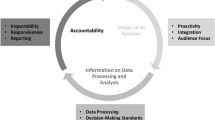Abstract
As a common practice in business enterprise systems, a service provider delegates a human agent to a client site to serve the client. On the other hand, in a computerized business application, enterprise organizations adopt Service-Oriented Architecture (SOA), where an enterprise agent is modeled as a software agent that cannot be transmitted efficiently by service messages. In the proposed approach, we extend the traditional architecture of SOA implementations to support generic and lightweight agents that reside at the client site. These agents, that we call “Service representatives”, can be customized and trained based on the provider generated role description and knowledge to perform their assigned tasks. In addition to providing innovative applications, such a technique allows for more sophisticated features such as maintaining client privacy and separating the functionality of the service and its delegated agent. To indicate the variety of roles that can be done by the service representative, we provide three case studies to show how a local and generic agent can be customized by different providers to personalize financial advice, apply medical guidelines, and verify credit card transactions.
Similar content being viewed by others
References
Soja P, Paliwoda-Pekosz G (2009) What are real problems in enterprise system. Ind Manag Data Syst 109(5): 610–627
Krafzig D, Banke K, Slama D (2005) Enterprise SOA: service oriented architecture best practices. Prentice-Hall, USA
Le D, Eck SA, Cao T (2007) A survey of web service discovery systems. Int J Inf Technol Web Eng 2(2): 65–80
Hung PCK, Li H, Jeng J (2004) WS-Negotiation: an overview of research issues. In: The 17th annual Hawaii international conference on system sciences, Hawaii, pp 10–18
Dustdar S, Schreiner W (2005) A survay on web service composition. Int J Web Grid Serv 1(1): 1–30
Baldauf M, Dustdar S, Rosenberg F (2007) A survey on context-aware systems. Int J Ad Hoc Ubiquitous Comput 2(4): 263–277
Huebscher MC, McCann JA (2008) A survey of autonomic computing—degrees, models, and applications. ACM Comput Surv 40(3): 1–28
Alessandrini M, Lippe W, Nuesser W (2008) Intelligent service system: an agent-based approach for integrating artifical intelligence components in SOA landscapes. In: International conference on web intelligence and intelligent agent technology, Sydney, pp 496–499
Sycara K, Paolucci M, Soundry J, Srinivasan N (2004) Dynamic discovery and coordination of agent-based semantic web service. IEEE Internet Comput 8(3): 66–73
Lee S, Choi K, Shin H, Shin D (2007) Ag Webs: web services based on intelligent agent platform. In: The 9th international conference on advanced communication technology, Phonex, Korea, pp 353–356
Cheng Y, Leon-Garcia A, Foster I (2008) Toward an autonomic service management framework: a holistic vision of SOA, AON, and autonomic computing. IEEE Commun Mag 46(5): 138–146
Xu B, Yang X, Shen Y, Shanping L, Ma A (2008) A role-based SOA architecture for community support systems. In: International symposium on collaborative technologies and systems, Irvine, pp 408–415
Maamar Z, Mostefaoui S, Yahyaoui H (2005) Toward an agent-based and context-oriented approach for web services composition. IEEE Trans Knowl Data Eng 17(5): 686–697
Yamato Y, Ohnishi H, Sunaga H (2008) Study of service processing agent for context-aware service coordination. In: IEEE international conference on service Computing, Hawaii, pp 275–282
Xiang L (2007) A multi-agent-based service-oriented architecture for inter-enterprise cooperation system. In: Second international conference on digital telecommunications, Silicon Vally, pp 22–32
Khalili A, Badrabadi A, Khoshalhan F (2008) A framework for distributed market place based on intelligent software agents and semantic web services. In: IEEE international congress on services part II, Hawaii, pp 141–148
Wong D, Paciorek N, Walsh T, DiCelie J, Young M, Peet B (1997) Concordia: an infrastructure for collaborating mobile agents. In: MA ’97: proceedings of the first international workshop on mobile agents, Springer London, pp 86–97
Wong D, Paciorek N, Moore D (1999) Java-based mobile agents. Commun ACM 42(3): 92–102
Pham V, Karmouch A (1998) Mobile software agents: an overview. IEEE Commun Mag 36: 26–37
Sangiorgi D, Walker D (2001) PI-Calculus: a theory of mobile processes. Cambridge University Press, New York
Zins C (2007) Knowledge map of information science. J Am Soc Inf Sci Technol 58(4): 526–535
IBM Corporation (2004) An architectural blueprint for autonomic computing, 4th edn. Technical report
Proctor M, Neale M, Lin P, Frandsen M (2008) Drools documentation. Technical report. JBoss.org
Raspl S (2004) PMML version 3.0—overview and status. In: proceedings of the ACM workshop on data mining standards, services and platforms, Philadelphia, pp 18–22
Haykin S (2008) Neural networks and learning machines. Prentice Hall, New York
Han J, Kamber M (2000) Data mining: concepts and techniques. Morgan Kaufmann Publishers, San Francisco
Compete III Vascular Tracker website. http://www.competestudy.com/
Brause R, Langsdorf T, Hepp M (1999) Neural data mining for credit card fraud detection. In: ICTAI ’99: proceedings of the 11th IEEE international conference on tools with artificial intelligence, IEEE Computer Society, Washington, p 103
Raffelt H, Margaria T, Steffen B, Merten M (2008) Hybrid test of web applications with webtest. In: Proceedings of the 2008 workshop on testing, analysis, and verification of web services and applications, ACM, New York, pp 1–7
Author information
Authors and Affiliations
Corresponding author
Rights and permissions
About this article
Cite this article
Najafi, M., Sartipi, K. Modeling service representatives in enterprise systems using generic agents. SOCA 5, 245–264 (2011). https://doi.org/10.1007/s11761-011-0088-5
Received:
Revised:
Accepted:
Published:
Issue Date:
DOI: https://doi.org/10.1007/s11761-011-0088-5




